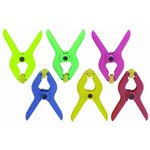prospect007
Full Member
- Mar 16, 2014
- 140
- 53
- Detector(s) used
- minelab 4000,fisher gb2,f75
- Primary Interest:
- All Treasure Hunting
a few mods that will improve recovery on the keene blower type dry washers, or any other blower type brands.
welding is required!!
note; the front of the dry washer is the discharge of the sluice box
1) put 1/4" raised expanded metal in the first 4 riffles, this keeps the gold from moving to the sides and roll out to the next riffle.
2) the counter weight on the fan needs to be cut in 1/2 and moved inward until it's flush with the fan blade.
the weight is to far out from the fan when it is shipped from the factory, and is to heavy, causing the larger rocks to separate and build up on one side.
3) put a level (one with a sticky back) on the back of the sluice box and one on the hopper.
the level on the sluice needs to be attached after you have run some dirt and can see that the flow is even across the sluice (from side to side). the level on the hopper needs to be attached when the rocks just begin to slide off the screen.
4) attach 4 adjustable legs. I used 1 1/2"long x 4 of 1"square tubing, drilled a hole in the side and welded a nut to it, then welded the tubing to the frame of the dry washer. use 3/4"square tubing for the legs. I made one set 12" the other set18". then I used a bolt to tighten the legs at what ever height I needed that would allow me to level the machine.
5) don't run the blower motor at full speed, that just blows out the finer gold. 1/2 to 3/4 speed is more than enough.
6) the outlet on the hopper should be 1-1/2 times the size of the classifier screen. 1/2" screen 3/4" opening.
7) cut out the back of the hopper so it is even across the discharge opening, then attach a slide gate in that area, this will help from plugging up by raising and lowering , instead of beating on the machine.
8)attach a piece of rubber (like 1/4" belting) to the back of the sluice. this prevents the wind from blowing the dirt from the hopper discharge out of the sluice.
These mods have help me get better recovery and made leveling easier, sluice feed are more consistant with less plug-ups. I am able to run3-4 loosened yards a day by my self.
I hope these mods help you all as well. pospector007
welding is required!!
note; the front of the dry washer is the discharge of the sluice box
1) put 1/4" raised expanded metal in the first 4 riffles, this keeps the gold from moving to the sides and roll out to the next riffle.
2) the counter weight on the fan needs to be cut in 1/2 and moved inward until it's flush with the fan blade.
the weight is to far out from the fan when it is shipped from the factory, and is to heavy, causing the larger rocks to separate and build up on one side.
3) put a level (one with a sticky back) on the back of the sluice box and one on the hopper.
the level on the sluice needs to be attached after you have run some dirt and can see that the flow is even across the sluice (from side to side). the level on the hopper needs to be attached when the rocks just begin to slide off the screen.
4) attach 4 adjustable legs. I used 1 1/2"long x 4 of 1"square tubing, drilled a hole in the side and welded a nut to it, then welded the tubing to the frame of the dry washer. use 3/4"square tubing for the legs. I made one set 12" the other set18". then I used a bolt to tighten the legs at what ever height I needed that would allow me to level the machine.
5) don't run the blower motor at full speed, that just blows out the finer gold. 1/2 to 3/4 speed is more than enough.
6) the outlet on the hopper should be 1-1/2 times the size of the classifier screen. 1/2" screen 3/4" opening.
7) cut out the back of the hopper so it is even across the discharge opening, then attach a slide gate in that area, this will help from plugging up by raising and lowering , instead of beating on the machine.
8)attach a piece of rubber (like 1/4" belting) to the back of the sluice. this prevents the wind from blowing the dirt from the hopper discharge out of the sluice.
These mods have help me get better recovery and made leveling easier, sluice feed are more consistant with less plug-ups. I am able to run3-4 loosened yards a day by my self.
I hope these mods help you all as well. pospector007
Last edited:





